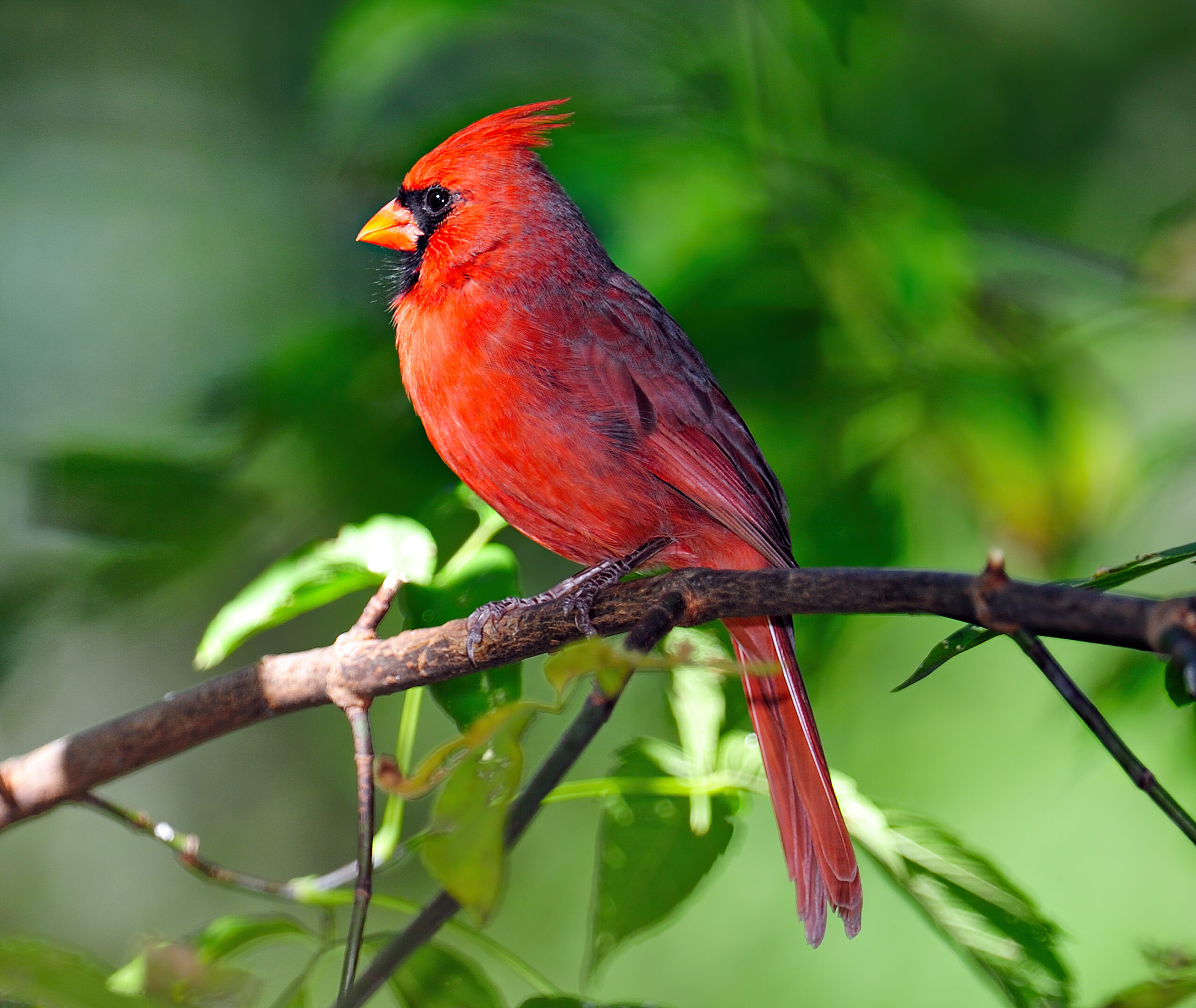What is the name of the 20 birds?
Birds come in many shapes, sizes, and behaviors. From backyard favorites to forest dwellers, here are 20 birds you’re most likely to encounter categorized by their ecological or physical types.
Songbirds (Passerines): Nature’s Natural Musicians
Songbirds, also known as passerines, make up the largest group of birds on Earth. You’ll recognize them by their colorful feathers, melodic songs, and the fact that most of them perch and hop around on branches or wires.
These birds are a big part of what gives life to your backyard in the morning especially in spring.
Let’s take a closer look at five of the most familiar songbirds in North America. I’ve personally spotted all of these in my own garden or nearby parks and trust me, once you learn to identify them, you’ll start noticing them everywhere.
1. American Robin
The American Robin is a sign of spring in many places. You’ll often see them hopping around lawns, searching for worms. They’re medium-sized with a bright orange breast and a gray-brown back.
-
Fun fact: Robins are one of the first birds to sing at dawn. Their soft, whistling tune is something you’ll learn to recognize quickly.
-
Where to see them: Lawns, parks, gardens — especially after rainfall.
2. Northern Cardinal
The male Northern Cardinal is hard to miss. He’s bright red all over with a sharp black mask around his beak. The female is more subtle light brown with soft red touches. Both are beautiful.
-
Why people love them: Cardinals stay year-round, even in winter, so seeing that bright red against the snow is stunning.
-
Sound: They have a clear, whistled song. Some say it sounds like “cheer-cheer-cheer” or “birdy-birdy-birdy.”
3. House Sparrow
House Sparrows are small, brown, and extremely social. They live almost everywhere humans do — from busy cities to quiet country homes.
-
Behavior: They travel in flocks and love to build nests in roofs, eaves, or signs.
-
Look for: The males have a black throat and chest, while females are plainer and lighter brown.
Although not native to North America (they were introduced from Europe), they’ve fully settled in and become part of the urban bird scene.
4. Blue Jay
Blue Jays are loud, bold, and very smart. Their bright blue feathers, white chest, and black markings make them stand out. You’ll often hear them before you see them they make a loud “jay jay” call and can even mimic other birds.
-
Behavior: They’re known to be clever and sometimes aggressive at feeders.
-
Interesting trait: Blue Jays can stash food like acorns in the ground to eat later helping plant new trees in the process.
5. Black-capped Chickadee
Chickadees are tiny and round with black heads, white cheeks, and fluffy bodies. They are curious birds and often come quite close to people, especially if you offer birdseed.
-
Sound: Their “chick-a-dee-dee” call is where they get their name.
-
Why they’re special: Chickadees stay active in winter, even in freezing temperatures, and fluff up to trap heat.
They’re friendly, fun to watch, and one of the easiest birds to attract to a backyard feeder with sunflower seeds or suet.
Why Songbirds Matter
Songbirds do more than sing pretty tunes. They control insects, spread seeds, and add life to your outdoor space. If you want to attract them, a basic bird feeder and a shallow water dish go a long way.
Let me know if you’d like a guide to bird feeders, binoculars, or seed types for these exact birds — I can help you build an Amazon affiliate post or comparison chart with ease.
Birds of Prey (Raptors): Nature’s Ultimate Hunters
Birds of prey, also called raptors, are some of the most fascinating creatures in the bird world. I’ve spent years watching them in the wild and studying their behaviors up close.
These birds hunt with precision using sharp talons and exceptional eyesight.
They play a critical role in keeping ecosystems balanced by controlling rodent and small animal populations.
Here are five of the most iconic raptors you can find across the United States.
6. Bald Eagle
The Bald Eagle is America’s national symbol for a reason. This large bird has a striking white head and tail contrasted against a dark brown body. Bald Eagles prefer habitats near lakes, rivers, and coasts because they hunt fish.
I once saw a Bald Eagle snatch a fish right out of a calm river. The power and grace in its flight amazed me. Their recovery from endangered status is one of the best wildlife success stories in the US.
7. Red-tailed Hawk
The Red-tailed Hawk is probably the raptor you see most often, especially if you drive through rural or suburban areas. Look for its broad wings and the reddish-brown tail that gives it its name.
I find these hawks perched on roadside poles, scanning for rodents below. Their call is a sharp, piercing scream often used in movies to represent any eagle or hawk. They adapt well to many environments, making them a common and important predator.
8. Barn Owl
Barn Owls have a ghostly appearance with their heart-shaped face and silent flight. Unlike many raptors, they hunt mainly at night using keen hearing to locate small mammals like mice and voles.
I remember hiking at dusk and spotting a Barn Owl silently swooping over a field. Their stealth and efficiency make them vital for natural rodent control on farms and open fields.
9. Peregrine Falcon
The Peregrine Falcon is the fastest animal on the planet, reaching speeds over 200 miles per hour in a hunting dive. These falcons hunt birds midair, striking with incredible speed and accuracy.
They nest on cliffs or tall city buildings, and I’ve spotted them near urban centers where they prey on pigeons. Their comeback after pesticide use nearly wiped them out is inspiring.
10. Osprey
Ospreys are fish specialists. You’ll often see them hovering over lakes or rivers, then plunging feet-first to catch fish. Their wingspan is large, and their hooked beak helps them hold slippery prey.
I’ve watched Ospreys build massive nests on platforms near water. They return to the same nests year after year, showing impressive loyalty.
Why Raptors Matter
Birds of prey keep nature in check. Their hunting controls populations of rodents, fish, and other animals. They are indicators of environmental health because they are sensitive to pollution and habitat loss.
If you want to attract or observe these birds, look for clean water sources and natural open spaces. You can also support conservation efforts or volunteer with local wildlife group.
Water Birds: Masters of Aquatic Life
Water birds are specially adapted to thrive near lakes, rivers, ponds, and wetlands. Over the years, I’ve enjoyed watching these birds in their watery habitats. Their unique features and behaviors make them stand out from other birds. Whether they swim, wade, or dive, water birds play a vital role in aquatic ecosystems.
Here are five common water birds you can spot around the United States.
11. Mallard Duck
Mallards are the classic ducks you probably see in city parks and natural ponds. The male sports a shiny green head and a bright yellow bill. Females are mottled brown, which helps them blend in while nesting.
I often feed Mallards at local parks. They are friendly but smart enough to know when to keep their distance. Mallards are dabblers, meaning they tip forward in the water to feed on plants and insects.
12. Great Blue Heron
The Great Blue Heron is tall and elegant. With its long legs and sharp bill, it patiently hunts fish and amphibians in shallow water.
I love watching a Great Blue Heron stand motionless for minutes, then strike with lightning speed to catch dinner. These birds are impressive hunters and an iconic sight along American waterways.
13. Canada Goose
Canada Geese are large birds easily recognized by their black necks and white cheek patches. They migrate in large flocks, often flying in the famous V-formation.
I’ve seen them graze in parks and on golf courses. They adapt well to human presence but need space to nest and raise their goslings. Their loud honking calls are unmistakable.
14. American Coot
The American Coot looks like a duck but is quite different. It has a black body, a white beak, and lobed feet that help it swim and walk on soft mud.
I often spot coots darting around freshwater lakes, sometimes racing across the surface like little speedboats. They eat plants and small aquatic creatures and tend to stay in groups.
15. Snowy Egret
The Snowy Egret is a slender white bird with black legs and bright yellow feet. It stalks shallow waters, using quick steps to flush out fish and frogs.
Their graceful movements and striking color make them stand out. I’ve seen Snowy Egrets in coastal marshes and wetlands, always busy hunting with focus and elegance.
Why Water Birds Matter
Water birds indicate the health of aquatic environments. They control fish and insect populations and help spread seeds and nutrients. Watching them offers a window into the life of lakes and rivers.
If you enjoy birdwatching, places like local ponds, wildlife refuges, and riverbanks are great spots to see these fascinating water birds. Adding native plants near water can even attract them to your backyard.
Ground or Game Birds: Walkers of the Wild
Ground birds, often called game birds, spend more time on their feet than in the air. These birds have strong legs for walking and running, and they rely on camouflage and quick bursts of flight to stay safe.
Over the years, I’ve had the chance to observe many of these birds while hiking or visiting wildlife reserves. Their behaviors and roles in nature make them fascinating subjects for bird lovers and hunters alike.
Here are three notable ground or game birds you’ll find in the U.S.
16. Wild Turkey
The Wild Turkey is a large, impressive bird famous for its fan-shaped tail and loud gobbling sounds. Males, called toms, put on elaborate strutting displays during mating season, puffing up their feathers to attract females.
I’ve watched turkeys parade through the forest floor, their tail feathers spread like a fan. Their presence signals a healthy forest ecosystem, as they forage on seeds, insects, and small amphibians.
17. Northern Bobwhite
The Northern Bobwhite is a small quail known for its distinctive “bob-white” call. This bird blends perfectly into grassy fields and brushy areas thanks to its camouflaged feathers.
Bobwhites stay close to the ground and often move in small groups called coveys. I once heard their call echoing on a quiet morning hike, a classic sign of early summer in the countryside.
18. Ring-necked Pheasant
Originally from Asia, the Ring-necked Pheasant is now a common game bird across North America. The males are striking, with bright colors, patterned feathers, and a distinctive white ring around their necks.
When startled, pheasants explode into quick, noisy flight that surprises even experienced birdwatchers. I remember trying to quietly approach a pheasant and being met with a sudden burst of wings and feathers. They are popular among hunters but also admired for their beauty.
Why Ground Birds Matter
Ground birds contribute to the balance of many habitats. They control insect populations and serve as prey for larger predators. For wildlife watchers and hunters, understanding their habits can deepen the appreciation of outdoor experiences.
If you want to attract or observe these birds, preserving natural brush areas and providing water sources helps. I’m happy to share tips on setting up feeders or cover plants that can support ground bird populations in your area.
Specialized and Unique Birds: Nature’s One-of-a-Kind Creatures
Some birds don’t quite fit the usual categories. They have special traits or behaviors that make them stand out.
From hovering in midair to drumming on tree trunks, these birds bring unique energy to any outdoor space.
I’ve spent years observing these fascinating birds and learning how they survive and thrive with their special skills.
Here are two of the most interesting specialized birds found across North America.
19. Hummingbird (Ruby-throated)
The Ruby-throated Hummingbird is the smallest bird you’ll find in North America. Its tiny size lets it hover in place as it feeds on nectar from flowers.
Their wings beat so fast, up to 50 times per second, that they create a humming sound that’s how they got their name.
I love watching hummingbirds dart around my garden in the summer. They’re full of energy, moving so quickly it’s hard to follow.
Providing a feeder or planting nectar-rich flowers invites these amazing creatures close to your home.
20. Woodpecker (Downy Woodpecker)
The Downy Woodpecker is a small bird with black and white markings. It pecks on tree trunks and branches searching for insects hidden under the bark.
The tapping sound it makes is a familiar rhythm in many forests and backyards.
I often hear the steady drumming before I spot one. These woodpeckers are excellent at keeping tree insects in check and are a sign of a healthy woodland. Their bold black-and-white pattern makes them easy to identify.
Why Specialized Birds Matter
Specialized birds like hummingbirds and woodpeckers fill unique roles in the ecosystem. They help with pollination, insect control, and even tree health. Observing their behaviors can bring a fresh appreciation for nature’s diversity.
If you want to attract these birds, focus on planting native flowers for hummingbirds and preserving trees or dead wood for woodpeckers.
I can help you find the best feeders, plants, or habitat tips to welcome these incredible birds to your outdoor space.
Final Thoughts
These 20 birds offer just a glimpse into the amazing diversity of bird species found across the U.S.
Whether you’re birdwatching in your backyard or hiking in the woods, knowing these types helps you connect more deeply with nature.







